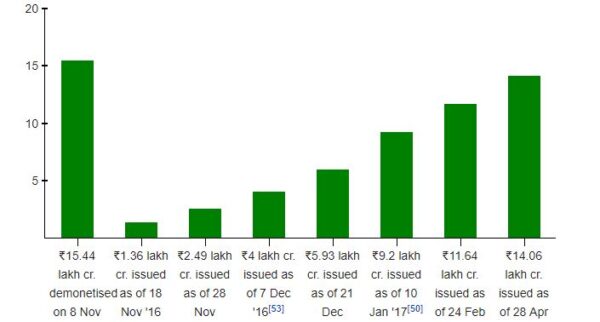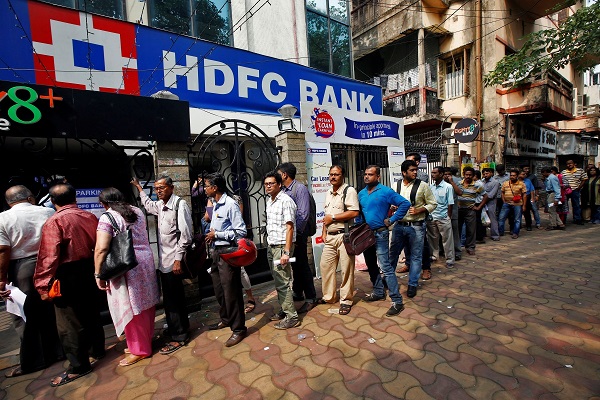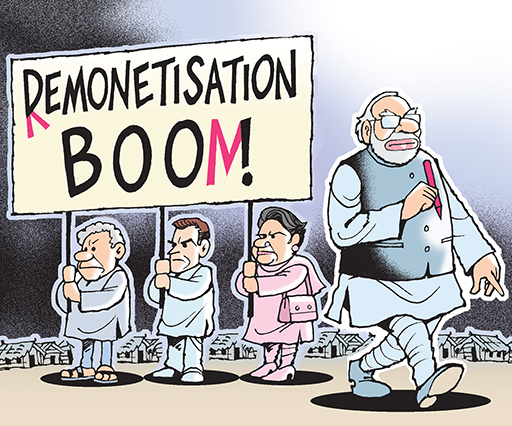Essay on demonetisation in English: On 8 November 2016, the Hon’ble Prime Minister of India, Mr. Narendra Modi, in a surprise move, announced the implementation of demonetisation or ‘notebandi’ (नोटबंदी in Hindi) with effect from the midnight of that day itself. The government reasoned that this sudden and unexpected move, even though it caused problems for the country’s people, would be an effective countermeasure to the rampant corruption and penetration of black money into the economy. This demonetisation essay will deal with the background, causes, effects, public opinion, advantages and disadvantages of demonetisation in India.
Demonetisation Essay
Origins of the idea: Demonetisation has earlier occurred two times in the Indian economy, both times the goal was to combat tax evasion through black money. The first demonetisation occurred in 1946, during the rule of the interim government under Jawaharlal Nehru. It was undertaken to target the tax-evading business corporations which were hiding the huge profits they had made by supplying the Allied powers in World War 2. The move was not viewed too positively by the then Governor of the RBI, Chintaman Deshmukh. He remarked that the government would be lucky to get Rs. 10 crores as tax after the implementation of demonetisation.
The second demonetisation took place in 1978 under the Janata Party government that had come into power after the defeat of the Congress party in the elections just after the Emergency of 1975-77. The process involved the demonetisation of Rs. 1000, Rs. 5000 and Rs. 10000 notes. The objective was, again, to combat tax evasion through black money. As in 1946, it did not enjoy any particular success.
The Process of Demonetization
Although there have been no official government announcements, analysts and experts have said that the process of demonetisation probably started 10 – 8 months prior to the announcement of demonetisation; i.e. early January or March 2016. This process included the printing of notes, the alteration of ATM machines to process the new currency, information given to key people so that a smooth transition could be affected, etc. Since all of the Mahatma Gandhi New Series carry the signature of Urjit Patel, we can conclude that process of printing the new notes was probably started after September 2016 when Urjit Patel had taken over.
During the time of the start of the process, Raghuram Rajan was the Governor of the RBI, however, all notes of the Mahatma Gandhi New Series bear the signature of Urjit Patel, who took over in September 2016. Whether this is due to Rajan’s strong opposition to demonetisation in general or because of good organization by the government is a matter of debate. Another aspect this brings up is that the initial phases of the process of demonetisation may have been carried out without the knowledge of Rajan due to his staunch opposition to demonetisation. If this is indeed true, it makes sense that all notes of the Mahatma Gandhi New Series bear Urjit Patel’s signature rather than that of Raghuram Rajan. (Check whether unconstitutional)
When demonetisation was announced, Rs. 15.44 lakh crore worth of notes stopped being legal tender. However only Rs. 1.36 lakh crore had been issued by 18 November 2016. This resulted in the cash shortages and long queues that come to most Indians’ mind when we think of the 2016 demonetisation.

Image courtesy: WikiPedia
The entire process of demonetisation was kept a closely guarded secret. Information was given to the people involved in the process only on a need to know basis. Due to this only around 10 people had the big picture. This level of security and secrecy ensured in extremely few leaks and even those were swept under the mat. The notable exceptions to this include a news report in the Hindi daily, Dainik Jagran which mentioned that new Rs. 2000 and Rs. 500 notes would be introduced, along with old Rs. 1000 and Rs. 500 notes being banned; the chairman of the SBI had also mentioned publicly in April 2016 about the possibility demonetisation.
Implementation of Demonetisation in India
By early November 2016, all the preparation was over and the Honourable Prime Minister Narendra Modi announced demonetisation of Rs. 1000 and Rs. 500 notes and the issue of new Rs. 2000 and Rs. 500 notes in their place to the Cabinet in a meeting just before his unscheduled broadcast over T.V. at 20zzx:15 IST on the 8th of November. Called ‘Notebandi’ in Hindi, demonetisation rendered the Rs. 1000 and Rs. 500 notes of the Mahatma Gandhi Series invalid starting from midnight of 8th November.
People could exchange their old notes in banks or deposit them in their bank accounts up to the 30th of December, 2016. The government decided that the 50-day window was sufficient for people to deposit or exchange all of their cash.
The limit for exchanging banknotes over the counters of banks varied over the process. It varied from Rs. 4000 in the beginning of demonetisation to Rs. 2000 a week later. Withdrawals too were limited at Rs. 10000 per day per account and Rs. 20000 per week per account. This was increased to Rs. 24000 per week per account from 14 November 2016.
There were government-sanctioned exceptions to the otherwise inflexible withdrawal limits: families could withdraw up to Rs. 250000 for weddings provided that their account was KYC compliant, exceptions were also made for farmers who could withdraw Rs. 25000 per week to pay loans.
Opinions on the Decision of Demonetisation
We, KnowlegeMerger’s have added up some opinions about demonetization’s impact in this demonetization essay just to make sure the essay has an untrodden strength throughout the web.
The move of demonetisation received extremely mixed views. It received support from many bankers, social workers, and businessmen who said that it would help curb black money, reduce criminal activities and accelerate e-commerce. However it was opposed by a sizeable amount of people: opposition politicians, economists, Chief Ministers of various states and external observers who said that it would not be effective in cleansing the economic system as most of the black money was held in the form of benami property, gold bullion and jewellery. However it is important to note that the opinion of the public about demonetisation leaned both ways across social media.
Support: Top bankers, businessmen, social workers and many politicians expressed their, support for demonetisation; saying that it would curb the rise of tax evasion through black money, land a major hit to forgery operations both within the country and without and also significantly reduce criminal activities like human trafficking, terrorist activities, etc. Many called it a bold and/or revolutionary step and praised the government. It received some international support as well, from articles in major magazines, views of eminent politicians, etc.
Criticism: A huge amount of PILs (Public Interest Litigations) were filed by people in the Supreme and High Courts by common people in opposition to the implementation of demonetisation. Many eminent economists said that it would not be effective in curbing black money and termed it a hollow move. A few opposition politicians supported the move, however they opposed the sudden and surprising process of implementation due to which the public had to go through much suffering. The government countered that if prior knowledge had been given, most of the black money would have been quickly transferred to overseas banks and hidden through other means like benami property, gold bullion, and jewelry. Chief Ministers of various states strongly opposed the move and made protests against it. Many economists and politicians stated that demonetisation would not work as most of the tax evaded money was held in the form of benami property, gold bullion, and jewelry. Some politicians stated that only around 4% of the black money in India was held in the form of cash.
Effects of Demonetisation In India
Banking: The banking system had its work cut out post demonetisation as people flocked to the banks to deposit their cash and withdraw what money they could. Long queues became the norm for people wishing to withdraw money. Some branches remained open overnight due to the overwhelming number of people in queues. Around Rs. 3 lakh crore was deposited in various bank branches in the first four days after demonetisation whereas only around Rs. 50,000 crores was withdrawn, this created the enormous cash shortage that came to define Indian demonetisation.
Crime: Human rights workers stated that human trafficking activities had seen a great decline immediately after demonetisation. However, post demonetisation the sex trafficking trade steadily grew again. Nobel Laureate Kailash Satyarthi attributed this to the absence of concrete steps by the government to curb the human trafficking business. However, due to demonetisation, the various radical terrorist groups in India suffered a huge blow as all of their stockpiled cash collected over the years became worthless. The surrender rate for Naxalites and Maoists has been the highest recorded in India immediately after demonetisation. Defence Minister Manohar Parrikar stated that demonetisation had also curbed terrorist activities in Kashmir, however, his claim has been disputed as the incidents of stone pelting and other terrorist activities did not see a remarkable decline post demonetisation. Hawala transactions were also reported to suffer a decline in Maharashtra and Kerala. This helped in reducing crime as Hawala transactions are the chief method of money laundering and transfer of funds for illegal activities in Western and South Western India. The Jammu and Kashmir police also reported the effect of demonetisation on terrorist funding and the separationist movement in Kashmir.
Cash Shortage: The main and immediate effect of demonetisation was acute cash shortage, this led to chaos in various parts of the country. ATMs would quickly run out of cash and many of the ATMs were non-functional. Violence broke out in some parts of the country including New Delhi. Some ATMs and bank premises were attacked, however there were no reports of any grievous injuries. Many ATMs were short of cash until April 2017 – 5 months after the start of demonetisation.
Deaths: The government denies having received any reports about deaths due to demonetisation. However, there are claims that people died due to standing in queues for long periods of time and also as hospitals refused to receive the old banknotes. Interestingly, there have been no deaths attributed to violence due to demonetisation. Opposition members place the death toll at around 100.
Transportation: Due to demonetisation, toll booths across the country refused to accept the old notes, this caused a disruption in transportation. Due to this, a suspension of toll collection across all booths was announced till 11 November 2016 this was later extended to 2 December 2016.
E-commerce and cashless society: Initially demonetisation was seen as an important step in bringing about a cashless society. Many e-commerce sites praised the move. Use of debit and credit cards, e-wallets and card swipe machines greatly increased. E-commerce sites reported a reduction in the use of the Cash on Delivery option to pay for goods. However, after peaking in December 2016 cashless transactions declined; this was seen as a failure of the objective to bring about a change in the spending habit. However, it is important to note that cashless transactions are still going strong in the country, although not at the level of cash transactions.
The Advantages and Disadvantages of Demonetsation are crafted out in a point-wise manner in this demonetisation essay. Move on and start reading…
Advantages of Demonetisation
The process of demonetisation had several positive effects on the Indian economy:
Promotion of a cashless society: One of the main reasons for implementing demonetisation was to initially promote a ‘less-cash’ and then a cashless society. This would change spending habits and ultimately result in more growth. Due to the unintentional cash shortages immediately after demonetisation, people were forced to use e-wallets, credit and debit cards and other methods of cashless transactions. Although this was not a smooth transition by any standards, it did help to bring about a ‘less-cash’ society and a change in spending habits. However, it is important to note that the great surge in use of cashless transactions declined soon after reaching its peak levels in December, 2016. Although India did not become an entirely cashless society, it did become a ‘less-cash’ society.
Combating note forgery: Due to the secretive and surprising nature of demonetisation, note forgers were caught unawares and forgery of notes within India and also in foreign countries like Nepal, Bangladesh, China and Pakistan suffered major setbacks. Although eventually the forgers were able to copy the new notes too, it took quite a lot of time and expenditure of resources.
Decline in crime: Due to the demonetisation of notes, criminal activities were badly hit. Hawala operations in Western and South Western India were badly hit. This resulted in a corresponding decrease in crime across those areas.
Decline in terrorist activities: All cash that the separatist terrorist groups like the Naxalites and the Maoists had amassed over the years was suddenly rendered useless post demonetisation. This resulted in the highest ever surrender rate for the terrorists immediately after demonetisation. Although these organisations attempted to exchange their money, sometimes forged, these were usually foiled by local police and led to even more arrests. Jammu and Kashmir police submitted a report stating that demonetisation had reduced the funding for separatist terrorist groups in Kashmir, thereby reducing their activities.
Decline in corruption: Many corrupt officials had amassed huge fortunes by accepting bribes, due to demonetisation all of this cash became useless and they had to dispose of it by dumping the cash, burning it or disposing of it by other means. These officials also became much more careful about accepting bribes and instances of accepting bribes reduced after demonetisation.
Disadvantages of Demonetisation
Like any process, demonetisation had certain unforeseen disadvantages of its own:
Lack of proper planning: Cash shortage was perhaps the greatest and most immediate disadvantage of demonetisation. The long queues outside ATMs and banks made people look a bit unfavorably at demonetisation. Many experts have stated that the government should have prepared more before announcing demonetisation, the government has countered that too much planning would have resulted in more leakage of information thus defeating the purpose of catching tax evaders unawares. However, it can be agreed that the government could have done more and better preparation before the announcement of demonetisation.
Failure to purge black money: Although the entire process was started by the government to purge the system of black money, expose and penalize the offenders and result in economic growth, it did not succeed in this objective. Around 99% of the circulating money was returned to the banking system without repercussions, thus tax evaders got away with their illegal gains. The reason why the tax evaders could get away was that most of their acquired money was in the form of benami property, gold bullion, and jewelry. The politician Sitaram Yechury said that only 6% of the black money in India was held in the form of cash. Many wrongdoers, in collaboration with corrupt bank officials, distributed their gains over many bank accounts to hide their money.
Fall in GDP: Due to demonetisation, global estimates for India’s GDP growth rate for 2016-2017 by around 2%. The actual GDP growth was 7.1%, a decrease from the 8% of the previous year. The GDP fell so much that it was the lowest since 2014. Although the Indian economy revived and continued its growth pattern, experts have attributed the GDP fall in 2016-2017 to demonetisation. As an interesting sidenote, the GDP pattern was exactly that which Dr. Manmohan Singh (the ex-Prime Minister of India) predicted in November 2016.
Drop in industrial output: The cash crisis adversely affected the industrial sector, with growth rates decreasing and a slowdown in both manufacturing and service industries. The growth in key sectors like cement, steel and refinery products decreased to 4.9% in November, compared with 6.6% in October.
Conclusion
So lastly, we are in the final part of the Demonetisation essay. In conclusion we can say that although the objectives of the 2016 demonetisation were noble; the process of implementation was sadly lacking and could have been smoother and better organised. The main goal of demonetisation – the total ‘eradication’ of black money and other corruption sourced money was met only with limited success, however, it very successfully fulfilled many of its secondary objectives – to destabilize separatist terrorist organizations and to reduce crime.
Demonetisation was an important event in modern Indian history, thus a demonetisation essay is an essential addition to any good blog. With the huge demand for a demonetisation essay by students, Civil Service Examinees and also other interested individuals, we decided to post an essay on demonetization on our site. Another important reason for which we wrote this demonetisation essay is that not all people truly have in-depth knowledge of the entire process of demonetisation, thus we felt it necessary to post an essay on demonetisation in English in our website.
Another important function served by this essay on demonetisation is that people can get verified information about an important topic that is often given in class assignments, projects, speeches, etc. The importance of a demonetization essay cannot be stressed in the current situation where there is an acute lack of a good demonetisation essay in essay books, guides etc. Also, it has been observed that there are extremely few websites that contain a demonetisation essay. Due to such a lack of demonetization essay, our website decided to provide a solution to the increasing public demand for a demonetization essay.
And yeah, you can use this essay as a speech on demonetization. If you want to learn how to write an effective speech, grant a visit to our parent site. Hope this article helped you!


